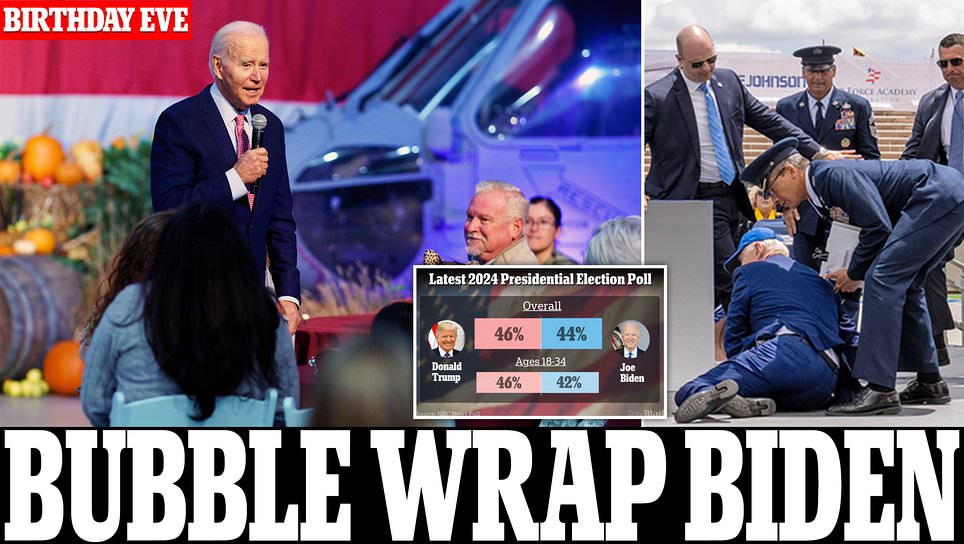pigfarmer
tall, thin, irritable
New emails show DHS created Stanford ‘disinfo’ group that censored speech before 2020 election
Josh Christenson
Published Nov. 6, 2023, 6:19 p.m. ET
New emails show officials at the Department of Homeland Security created a Stanford University “disinformation” group that censored Americans’ speech before the 2020 election, according to a House Judiciary Committee report exclusively obtained by The Post.
The House panel’s 103-page staff interim report says never-before-seen emails and internal communications were obtained from the group, known as the Election Integrity Partnership (EIP), and show how it worked with DHS’ Cybersecurity and Infrastructure Security Agency (CISA) to flag, suppress and remove online speech in coordination with big tech companies.
One of EIP’s founding partners — the Atlantic Council’s Digital Forensic Research Lab — described CISA’s central role in the alleged censorship effort in a July 31, 2020, email.
“I know the Council has a number of efforts on broad policy around the elections, but we just set up an election integrity partnership at the request of DHS/CISA and are in weekly comms to debrief about disinfo,” the lab’s senior director Graham Brookie wrote.
The staff report says, “[T]he federal government and universities pressured social media companies to censor true information, jokes, and political opinions.
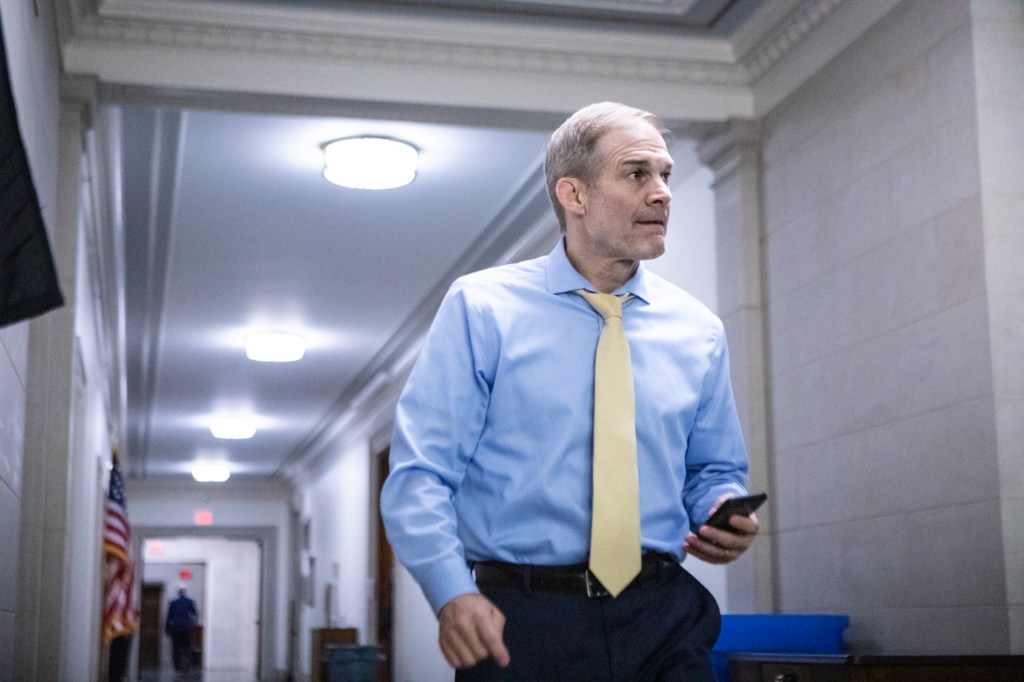 9
9
A report from the House Judiciary Committee, led by Chairman Jim Jordan (R-Ohio), says new emails show officials at the Department of Homeland Security created a Stanford University “disinformation” group that censored Americans’ speech before the 2020 election.Getty Images
 9
9
Graham Brookie, director of the Atlantic Council’s Digital Forensic Research Lab, described a federal agency’s central role in the alleged censorship effort in a July 31, 2020, email.Atlantic Council
 9
9
Here is a related email from Atlantic Council DFR Lab Senior Director Graham Brookie.NY Post
 9
9
The online posts labeled “misinformation” were made by public officials such as former President Donald Trump.Getty Images
“This pressure was largely directed in a way that benefitted one side of the political aisle: true information posted by Republicans and conservatives was labeled as ‘misinformation’ while false information posted by Democrats and liberals was largely unreported and untouched by the censors.”
The “misinformation” posts were made by public officials such as former President Donald Trump, Sen. Thom Tillis (R-NC), Rep. Thomas Massie (R-Ky.), media outlets such as Newsmax and The Babylon Bee and many conservative commentators.
The Judiciary report also found that while under the purview of CISA’s Countering Foreign Influence Task Force, the central focus of the feds’ effort was to “censor Americans engaged in core political speech in the lead up to the 2020 election.”
DHS acknowledged that it could not “openly endorse” a centralized portal to flag information in a May 2020 email released in the staff report, which cleared the way for Stanford’s EIP to take up the effort in July of that year.
The task force used a tactic known as “switchboarding” to refer to removal requests from state and local officials to Facebook, Twitter and other social media sites, which CISA-CFITF Director Brian Scully confirmed in testimony in the bombshell case Missouri v. Biden.
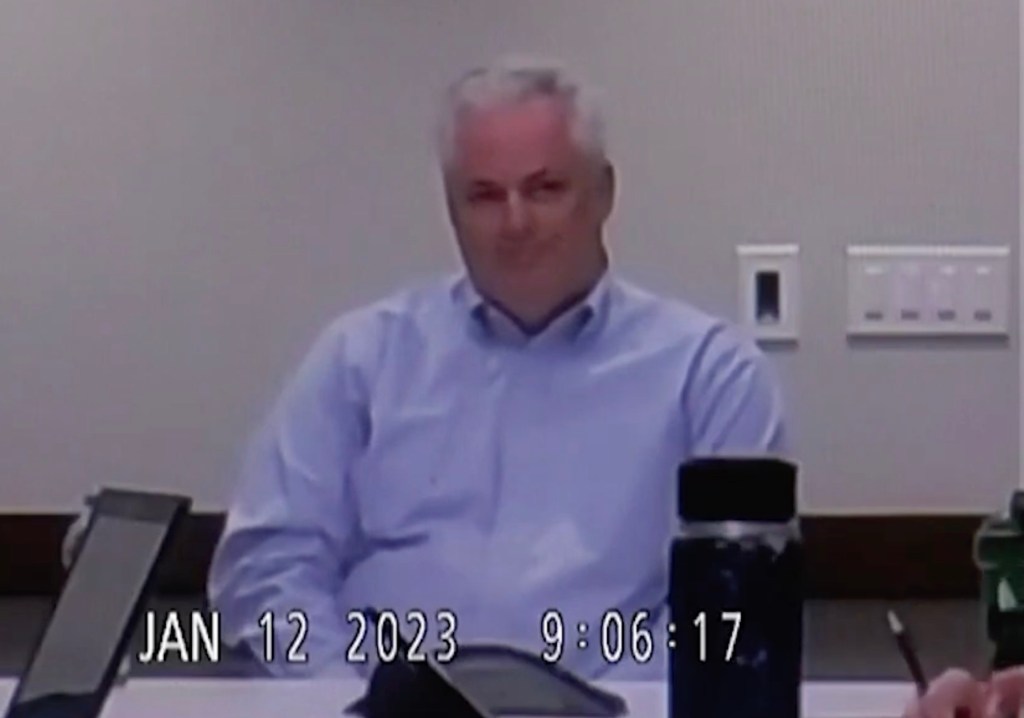 9
9
Brian Scully, a figure in the controversy, gave testimony in the bombshell case Missouri v. Biden.New Civil Liberties Alliance / Youtube
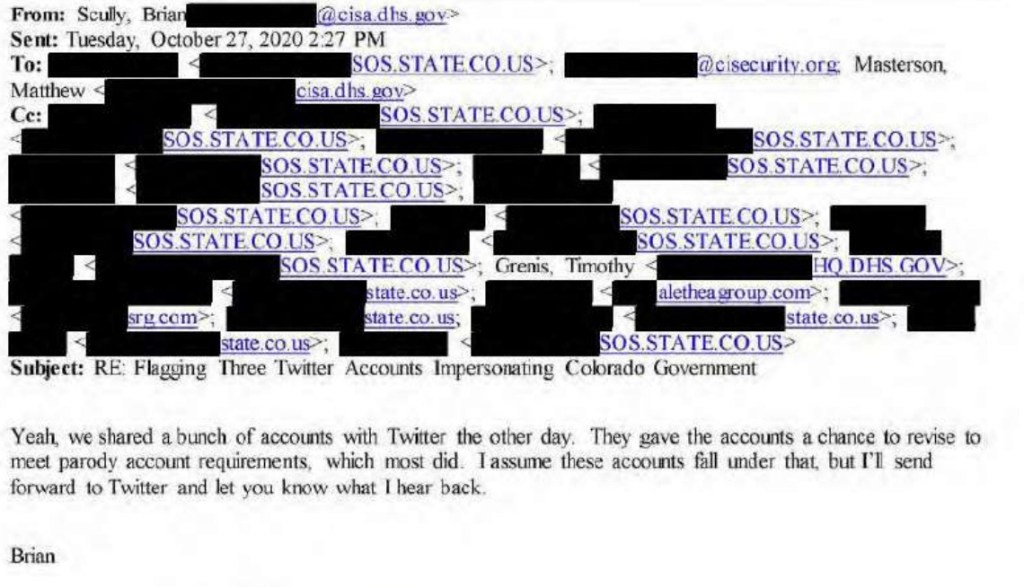 9
9
Emails in the interim staff report show Scully informing members of the Office of the Colorado Secretary of State that he had flagged parody accounts to Twitter.NY Post
Emails in the interim staff report show Scully informing members of the Office of the Colorado Secretary of State that he had flagged parody accounts to Twitter and advised Facebook to take down a post about the election that was deemed misinformation.
The exchanges show that CISA recognized it was on shaky legal grounds by participating in the effort and chose to add a disclaimer beneath many emails that its requests were “voluntary” and the agency “neither has nor seeks the ability to remove what information is made available on social media platforms.”
However, those emails also included a line that the “information may also be shared with law enforcement or intelligence agencies,” implying those agencies could take action if the posts weren’t removed.
Former CISA Director Chris Krebs, who was fired by Trump after the 2020 election, testified to the subcommittee that “switchboarding” was done before his agency was created as well.
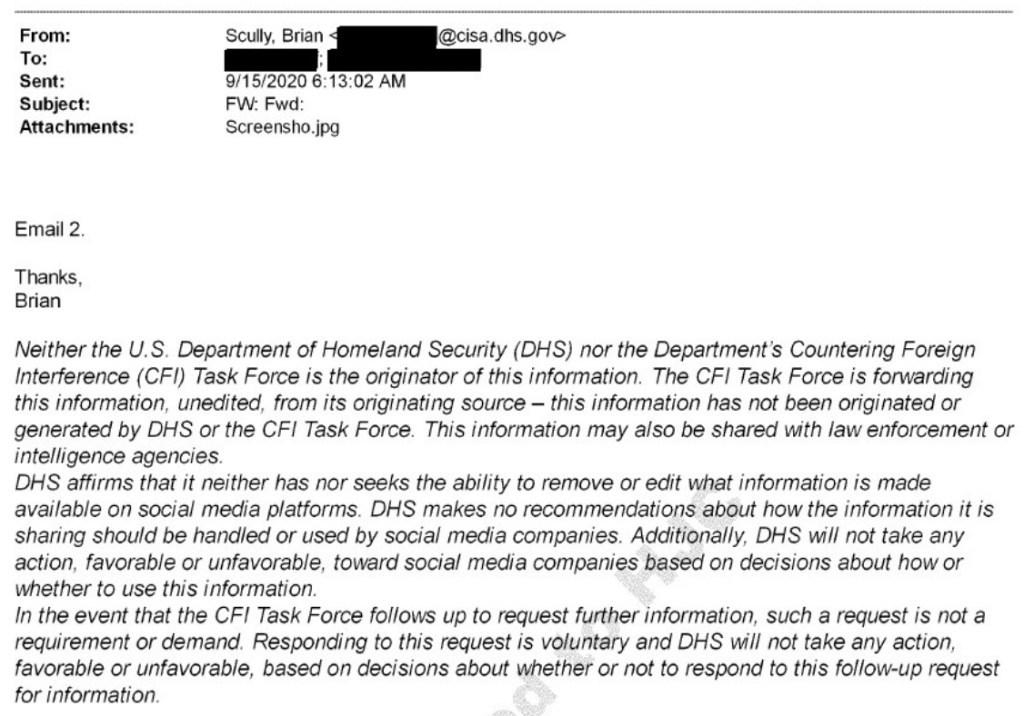 9
9
Exchanges show that group recognized it was on shaky legal ground by participating in the effort and chose to add a disclaimer beneath many emails that its requests were “voluntary.”NY Post
Homeland Security Secretary Alejandro Mayorkas testified in a House Judiciary Committee hearing in July that the agency no longer participates in the practice.
The Judiciary staff report also discloses that Stanford students were working at both CISA and EIP simultaneously.
“Not only were there a number of university students involved with the EIP, at least four of the students were employed by CISA during the operation of EIP, using their government email accounts to communicate with CISA officials and other ‘external stakeholders’ involved with the EIP,” it states.
 9
9
Former CISA Director Chris Krebs, who was fired by Trump after the 2020 election, testified to the subcommittee.Jim LoScalzo / Greg Nash / Pool via CNP / SplashNews.com
In a statement given to The Post on Monday, CISA Executive Director Brandon Wales said the agency “does not and has never censored speech or facilitated censorship.
“Every day, the men and women of CISA execute the agency’s mission of reducing risk to U.S. critical infrastructure in a way that protects Americans’ freedom of speech, civil rights, civil liberties, and privacy,” Wales said.
“In response to concerns from election officials of all parties regarding foreign influence operations and disinformation that may impact the security of election infrastructure, CISA mitigates the risk of disinformation by sharing information on election literacy and election security with the public and by amplifying the trusted voices of election officials across the nation.”
The “disinfo” organization was led by Stanford University’s Stanford Internet Observatory (SIO) and founded with the help of other academics who communicated directly with Homeland Security officials and members of the State Department’s Global Engagement Center (GEC), the report said.
SIO was conceived as a “one-stop shop for local election officials, DHS, and voter protection organizations” to coordinate with social media platforms in the censorship effort, according to its director Alex Stamos, who previously served as chief security officer at Facebook.
In June, Stamos testified to the House subcommittee that CISA’s coordination with the FBI came across as a threat.
 9
9
Alex Stamos, who previously served as chief security officer at Facebook, said the idea was to create a “one-stop shop for local election officials, DHS, and voter protection organizations” to coordinate with social media platforms in the censorship effort.REUTERS
“[D]ealing with a law enforcement agency that has coercive powers is just a risky thing to do if you’re part of some big organization and some other — there might be some investigation involving the organization that you don’t even know about,” he said.
“I think all executives of all public companies understand that there’s lots of parts of the government that can punish you for activity that you thought was appropriate.”
Stamos did not immediately respond to a request for comment.
Trump established CISA in 2018 to improve federal cybersecurity programs and protect government software from hackers.
New emails show DHS created Stanford ‘disinfo’ group that censored speech before 2020 election
ByJosh Christenson
Published Nov. 6, 2023, 6:19 p.m. ET
New emails show officials at the Department of Homeland Security created a Stanford University “disinformation” group that censored Americans’ speech before the 2020 election, according to a House Judiciary Committee report exclusively obtained by The Post.
The House panel’s 103-page staff interim report says never-before-seen emails and internal communications were obtained from the group, known as the Election Integrity Partnership (EIP), and show how it worked with DHS’ Cybersecurity and Infrastructure Security Agency (CISA) to flag, suppress and remove online speech in coordination with big tech companies.
One of EIP’s founding partners — the Atlantic Council’s Digital Forensic Research Lab — described CISA’s central role in the alleged censorship effort in a July 31, 2020, email.
“I know the Council has a number of efforts on broad policy around the elections, but we just set up an election integrity partnership at the request of DHS/CISA and are in weekly comms to debrief about disinfo,” the lab’s senior director Graham Brookie wrote.
The staff report says, “[T]he federal government and universities pressured social media companies to censor true information, jokes, and political opinions.
 9
9A report from the House Judiciary Committee, led by Chairman Jim Jordan (R-Ohio), says new emails show officials at the Department of Homeland Security created a Stanford University “disinformation” group that censored Americans’ speech before the 2020 election.Getty Images
 9
9Graham Brookie, director of the Atlantic Council’s Digital Forensic Research Lab, described a federal agency’s central role in the alleged censorship effort in a July 31, 2020, email.Atlantic Council
 9
9Here is a related email from Atlantic Council DFR Lab Senior Director Graham Brookie.NY Post
 9
9The online posts labeled “misinformation” were made by public officials such as former President Donald Trump.Getty Images
“This pressure was largely directed in a way that benefitted one side of the political aisle: true information posted by Republicans and conservatives was labeled as ‘misinformation’ while false information posted by Democrats and liberals was largely unreported and untouched by the censors.”
The “misinformation” posts were made by public officials such as former President Donald Trump, Sen. Thom Tillis (R-NC), Rep. Thomas Massie (R-Ky.), media outlets such as Newsmax and The Babylon Bee and many conservative commentators.
The Judiciary report also found that while under the purview of CISA’s Countering Foreign Influence Task Force, the central focus of the feds’ effort was to “censor Americans engaged in core political speech in the lead up to the 2020 election.”
DHS acknowledged that it could not “openly endorse” a centralized portal to flag information in a May 2020 email released in the staff report, which cleared the way for Stanford’s EIP to take up the effort in July of that year.
The task force used a tactic known as “switchboarding” to refer to removal requests from state and local officials to Facebook, Twitter and other social media sites, which CISA-CFITF Director Brian Scully confirmed in testimony in the bombshell case Missouri v. Biden.
 9
9Brian Scully, a figure in the controversy, gave testimony in the bombshell case Missouri v. Biden.New Civil Liberties Alliance / Youtube
 9
9Emails in the interim staff report show Scully informing members of the Office of the Colorado Secretary of State that he had flagged parody accounts to Twitter.NY Post
Emails in the interim staff report show Scully informing members of the Office of the Colorado Secretary of State that he had flagged parody accounts to Twitter and advised Facebook to take down a post about the election that was deemed misinformation.
The exchanges show that CISA recognized it was on shaky legal grounds by participating in the effort and chose to add a disclaimer beneath many emails that its requests were “voluntary” and the agency “neither has nor seeks the ability to remove what information is made available on social media platforms.”
However, those emails also included a line that the “information may also be shared with law enforcement or intelligence agencies,” implying those agencies could take action if the posts weren’t removed.
Former CISA Director Chris Krebs, who was fired by Trump after the 2020 election, testified to the subcommittee that “switchboarding” was done before his agency was created as well.
 9
9Exchanges show that group recognized it was on shaky legal ground by participating in the effort and chose to add a disclaimer beneath many emails that its requests were “voluntary.”NY Post
Homeland Security Secretary Alejandro Mayorkas testified in a House Judiciary Committee hearing in July that the agency no longer participates in the practice.
The Judiciary staff report also discloses that Stanford students were working at both CISA and EIP simultaneously.
“Not only were there a number of university students involved with the EIP, at least four of the students were employed by CISA during the operation of EIP, using their government email accounts to communicate with CISA officials and other ‘external stakeholders’ involved with the EIP,” it states.
 9
9Former CISA Director Chris Krebs, who was fired by Trump after the 2020 election, testified to the subcommittee.Jim LoScalzo / Greg Nash / Pool via CNP / SplashNews.com
In a statement given to The Post on Monday, CISA Executive Director Brandon Wales said the agency “does not and has never censored speech or facilitated censorship.
“Every day, the men and women of CISA execute the agency’s mission of reducing risk to U.S. critical infrastructure in a way that protects Americans’ freedom of speech, civil rights, civil liberties, and privacy,” Wales said.
“In response to concerns from election officials of all parties regarding foreign influence operations and disinformation that may impact the security of election infrastructure, CISA mitigates the risk of disinformation by sharing information on election literacy and election security with the public and by amplifying the trusted voices of election officials across the nation.”
The “disinfo” organization was led by Stanford University’s Stanford Internet Observatory (SIO) and founded with the help of other academics who communicated directly with Homeland Security officials and members of the State Department’s Global Engagement Center (GEC), the report said.
SIO was conceived as a “one-stop shop for local election officials, DHS, and voter protection organizations” to coordinate with social media platforms in the censorship effort, according to its director Alex Stamos, who previously served as chief security officer at Facebook.
In June, Stamos testified to the House subcommittee that CISA’s coordination with the FBI came across as a threat.
 9
9Alex Stamos, who previously served as chief security officer at Facebook, said the idea was to create a “one-stop shop for local election officials, DHS, and voter protection organizations” to coordinate with social media platforms in the censorship effort.REUTERS
“[D]ealing with a law enforcement agency that has coercive powers is just a risky thing to do if you’re part of some big organization and some other — there might be some investigation involving the organization that you don’t even know about,” he said.
“I think all executives of all public companies understand that there’s lots of parts of the government that can punish you for activity that you thought was appropriate.”
Stamos did not immediately respond to a request for comment.
Trump established CISA in 2018 to improve federal cybersecurity programs and protect government software from hackers.







